I sure recommend you wire up the basic system and SEE if you have any deficiencies you really, really want to fix by complicated means. Maybe you'll have too much box resonance at 16 Hz and will need to taper off some. Test.
Ordinarily, when a manufacturer has low-end protection, it isn't anything special. Just some simple capacitor that keeps DC and frequencies above at bay. As I said earlier, these caps are very loosely rated and hence often vastly over-sized. Ill-informed people are talking as it there's some kind of precise EQ that rolls off spot-on at 18 Hz and plays nothing below.
I can't believe that people righteously put forth silly arguments about inconceivably fussy fixes without figuring out if there's a practical problem other than in theoretical simulations of the chain of pieces.
Yes, DCX2496 retains memory. Exceedingly long learning curve for new users. Likely to make many mistakes for weeks. DAMHIK*.
Beni
*and after two yrs, still making mistakes; but I think it is a truly indispensable tool for home HiFi
I wouldn't really characterize them as silly. Everyone is looking for a way to squeeze out a few more decibels of those lows. They're trying to be helpful. There's nothing wrong with that. But the truth is that budget restraints have now limited my available new options. In some ways that may be a good thing.
For good or for ill, we're going to go online with what we have. Then with time for the organ fund to build up a little AND time for me to live with the resulting sound, I may actually try some of those ideas.
Bach On
Note I wasn't suggesting you purchase a DCX2496. I was suggesting that an iNuke could be the cheapest way for high power subsonic amping. The thread I linked to is applicable for all Behringer DSP, including the iNuke amps.
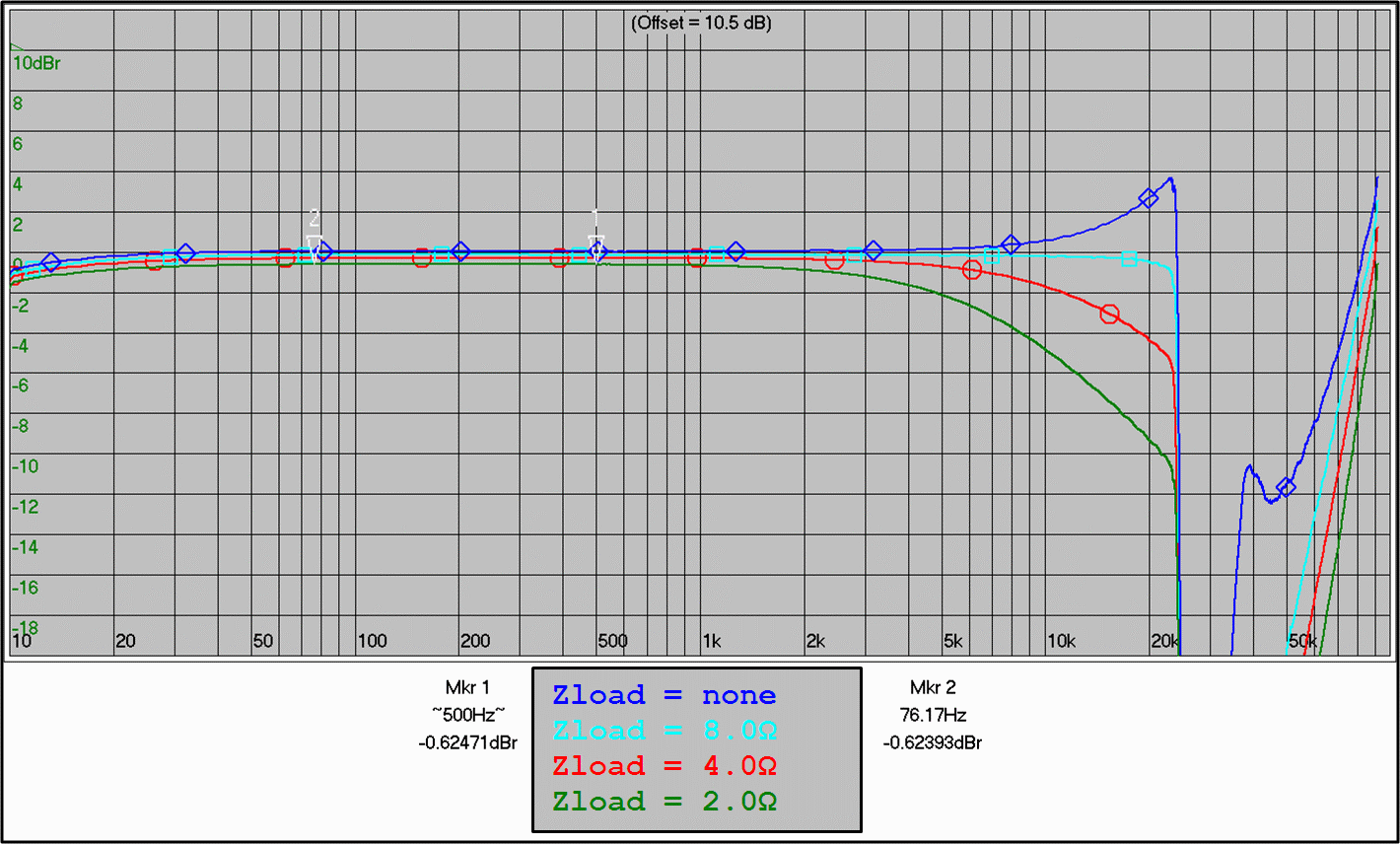
This is a load test for an iNuke 3000dsp ($280). The LF rolloff is mild- potentially less than 1db. The thread I linked also details how you can do filter trickery to produce a high pass as low as 10hz despite the software not allowing anything set under 20hz.

This is a load test for an iNuke 3000dsp ($280). The LF rolloff is mild- potentially less than 1db. The thread I linked also details how you can do filter trickery to produce a high pass as low as 10hz despite the software not allowing anything set under 20hz.
Originally Posted by mwmkravchenko
Do the mod on the rolls box, as the roll offs do accumulate.
Yes & yes
At the very least he knows what he is talking about.
Very nice of you to say so
Hey, it's the least I can do for a guy that is after Zero Distortion. (Zero D?)
I'm after it on the mechanical end.
I looked back at my post as to why the levels from the CD player did not work and I have the voltages backwards.
Sometimes I wish I could go back and fix such mistakes.
But them that makes no mistakes makes no things.
I'm after it on the mechanical end.
I looked back at my post as to why the levels from the CD player did not work and I have the voltages backwards.
Sometimes I wish I could go back and fix such mistakes.
But them that makes no mistakes makes no things.
OK. I went over to a hot church this afternoon to do some testing. Don't tell the thermostat police but I turned up the air a bit to do my work. Hey! It's for a good cause.
Let me tell you guys upfront that I just don't like REW. It seems clear that I have something set wrong in it. I can't get the recording sound level high enough to take useful measurements. I'll do some more reading in the Help system, but I used my other program to take some measurements. I did use REW to run some sweeps. TrueRTA doesn't have that feature. But the measurements I'm about to post came from TrueRTA.
I began with the amp in bridged mode. I set the gain for about 60%. The mike is on a stand about 4 feet in front of the driver about 4 feet above the carpeted floor. I ran sine waves at three different frequencies.
Here's one at a nominal 64 Hz.
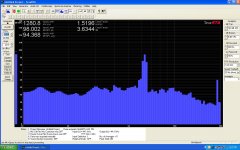
Here's 32 Hertz
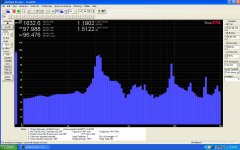
And here is 16 Hertz
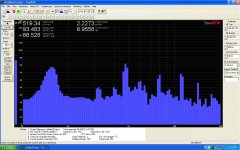
Just for comparison, here is a measurement from the Lowest C of one of the 16 foot Bourdon pipes. The mike was about a foot or two from the pipe. I made this one about two weeks ago. (These are the pipes we will be removing and discarding.)
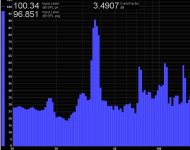
I'll upload some more pics in the next post.
Bach On
Let me tell you guys upfront that I just don't like REW. It seems clear that I have something set wrong in it. I can't get the recording sound level high enough to take useful measurements. I'll do some more reading in the Help system, but I used my other program to take some measurements. I did use REW to run some sweeps. TrueRTA doesn't have that feature. But the measurements I'm about to post came from TrueRTA.
I began with the amp in bridged mode. I set the gain for about 60%. The mike is on a stand about 4 feet in front of the driver about 4 feet above the carpeted floor. I ran sine waves at three different frequencies.
Here's one at a nominal 64 Hz.

Here's 32 Hertz

And here is 16 Hertz

Just for comparison, here is a measurement from the Lowest C of one of the 16 foot Bourdon pipes. The mike was about a foot or two from the pipe. I made this one about two weeks ago. (These are the pipes we will be removing and discarding.)

I'll upload some more pics in the next post.
Bach On
I don't want to run the amp in Bridged mode, so I switched it over to run in a mode using the Single input. The Lowpass filter was set at 96 Hertz. When running in crossover mode, only Input 1 is used. Both output channels work independently on the same signal. The volume controls control the outputs to two different speakers. The gain was set at roughly 80% for this test. The XLS1500 can provide up to 525 watts per output channel at 4 ohms. So you can get a general idea of how much power is being used. Remember that this box and the twin Dayton box will be reproducing the same signal. The Dayton will be on the other output channel. The following measurements are only for the newer Triangular box Oliver designed using a single SI HT18.
Here's 64 Hertz. All other things the same.
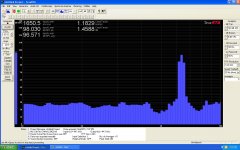
Here's 32 Hertz
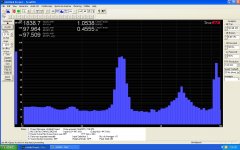
And a nominal 16 Hz.
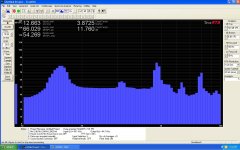
A couple of the guys over at the organ forum don't like ported speakers. They suggested I try plugging up the port so it was more like a sealed box. I did so. The plug wasn't perfect, but it was pretty close to sealed.
I ran a set of sweeps from 96 down to 16 Hertz. The SPL was very even from 96 down to about 30 Hz. Then it fell off by half from 30 to 24. Then it faded away to almost nothing below 20.
I ran a measurement with the port sealed at 16 Hertz.
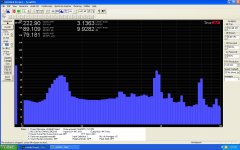
I didn't do any more measurements. But I did remove the cap to reopen the port. I ran the same sweeps. The ride is not nearly as smooth from 96 down to 32. But it is far more substantial below 24 Hertz. And the SPL at 16 won't knock your socks off, but it has a lot more substance than the sealed configuration.
I didn't take a voltmeter to measure the electrical signal at those low frequencies. It seems clear from what Crown wrote me that the signal below 20 Hertz is down.
So if I want a smooth frequency response in this range, a sealed box does it better - at least down to 24 Hertz. But if I want more SPL below 24 Hertz, the port in this box seems to provide it.
But I do have a problem with the cabinet. There is a slight leak along the front panel where the joint between the two parts of the box meet. I used an entire tube of non-silicone caulk to try to make a secure seal. But there's still a slight noise. You can just hear it standing near the cabinet. It is not very noticeable from, say, 10 or 12 feet away.
I'm going to have to focus my attention on that joint. I don't want any leaks. Looks like I'm going to have to do something different.
Still, not a bad day. (And yes, I did turn the thermostat back where it was.)
Bach On
Here's 64 Hertz. All other things the same.

Here's 32 Hertz

And a nominal 16 Hz.

A couple of the guys over at the organ forum don't like ported speakers. They suggested I try plugging up the port so it was more like a sealed box. I did so. The plug wasn't perfect, but it was pretty close to sealed.
I ran a set of sweeps from 96 down to 16 Hertz. The SPL was very even from 96 down to about 30 Hz. Then it fell off by half from 30 to 24. Then it faded away to almost nothing below 20.
I ran a measurement with the port sealed at 16 Hertz.

I didn't do any more measurements. But I did remove the cap to reopen the port. I ran the same sweeps. The ride is not nearly as smooth from 96 down to 32. But it is far more substantial below 24 Hertz. And the SPL at 16 won't knock your socks off, but it has a lot more substance than the sealed configuration.
I didn't take a voltmeter to measure the electrical signal at those low frequencies. It seems clear from what Crown wrote me that the signal below 20 Hertz is down.
So if I want a smooth frequency response in this range, a sealed box does it better - at least down to 24 Hertz. But if I want more SPL below 24 Hertz, the port in this box seems to provide it.
But I do have a problem with the cabinet. There is a slight leak along the front panel where the joint between the two parts of the box meet. I used an entire tube of non-silicone caulk to try to make a secure seal. But there's still a slight noise. You can just hear it standing near the cabinet. It is not very noticeable from, say, 10 or 12 feet away.
I'm going to have to focus my attention on that joint. I don't want any leaks. Looks like I'm going to have to do something different.
Still, not a bad day. (And yes, I did turn the thermostat back where it was.)
Bach On
Last edited:
A number of things from your measurements, and the measurement process:
1. If you click on the TruRTA chart, it will highlight the measurement right under the mouse's cursor. This could be useful for highlighting specific frequencies in a screen shot.
2. If your system is capable of doing sine sweeps, try activating the "peak hold" setting in TruRTA when performing a sweep.
3. The graphs appear to show a considerable amount of distortion at lower frequencies, if you did indeed test with sign waves. The high 3rd order stuff suggests a clipping signal, quite likely the mic input into the PC running TruRTA. If that's the case, then the measurements are suspect and need to be redone. Unfortunately I don't think TruRTA has a means of negating a measurement when the input is clipped, so you will have to experiment with different levels to ensure the clipping does not happen.
1. If you click on the TruRTA chart, it will highlight the measurement right under the mouse's cursor. This could be useful for highlighting specific frequencies in a screen shot.
2. If your system is capable of doing sine sweeps, try activating the "peak hold" setting in TruRTA when performing a sweep.
3. The graphs appear to show a considerable amount of distortion at lower frequencies, if you did indeed test with sign waves. The high 3rd order stuff suggests a clipping signal, quite likely the mic input into the PC running TruRTA. If that's the case, then the measurements are suspect and need to be redone. Unfortunately I don't think TruRTA has a means of negating a measurement when the input is clipped, so you will have to experiment with different levels to ensure the clipping does not happen.
A number of things from your measurements, and the measurement process:
1. If you click on the TruRTA chart, it will highlight the measurement right under the mouse's cursor. This could be useful for highlighting specific frequencies in a screen shot.
2. If your system is capable of doing sine sweeps, try activating the "peak hold" setting in TruRTA when performing a sweep.
3. The graphs appear to show a considerable amount of distortion at lower frequencies, if you did indeed test with sign waves. The high 3rd order stuff suggests a clipping signal, quite likely the mic input into the PC running TruRTA. If that's the case, then the measurements are suspect and need to be redone. Unfortunately I don't think TruRTA has a means of negating a measurement when the input is clipped, so you will have to experiment with different levels to ensure the clipping does not happen.
Brian - I use an ART Dual Pre for the in and out interface. It has a pot for adjusting the mike input. It is quite possible that it was too hot. It has an indicator LED for when there is clipping. Frankly, I didn't look at that. So clipping is a possibility. I can try to adjust that tomorrow. I'm still learning how to use the program. I'll try to magnify the fundamental to see what it does. Thanks for the tip.
The only sweep I see in TrueRTA is a button that runs a quick sweep. It is a sweep that last about a second. And I don't know the frequencies it includes. I've not seen any other sweeps in the program.
REW has a very flexible Sweep feature. It has both Log Sweep and Linear Sweep. I do not know if I can use REW to produce the sweep AND use TrueRTA to do the measurement. I'll experiment with that.
TrueRTA does have a Peak Hold Button.
Bach On
Bach On, you may want to try measuring "near field", with the mic right next to the speaker cone (and also next to the port), maybe 1 cm away. You'll get less room, and more accurate results.
OK. I can make those measurements.
Bach On
Hold on the close mic.
The idea is good and noble.
The application is incorrect.
We already know that your enclosure can reproduce the required tones.
A close mic test must be done at much lower SPL. Otherwise you will be overloading your mic.
This is an inplace performance test. Not a chasing after beautiful response curves.
Otherwise you did good Ron.
Each of those tests are telling me that you have achieved most of what you want already.
The idea is good and noble.
The application is incorrect.
We already know that your enclosure can reproduce the required tones.
A close mic test must be done at much lower SPL. Otherwise you will be overloading your mic.
This is an inplace performance test. Not a chasing after beautiful response curves.
Otherwise you did good Ron.
Each of those tests are telling me that you have achieved most of what you want already.
Right. "Up close" is not your meaningful test. "In the pews" is.Hold on the close mic.
This is an inplace performance test. Not a chasing after beautiful response curves.
Otherwise you did good Ron.
Each of those tests are telling me that you have achieved most of what you want already.
But the frequency response (and distortion) curves are needed. When doing the curves, important to run say, 10-200 to have the context for the 16-64 you are most interested in.
REW does something weird on my Mac. You need to quit REW THEN choose the external mic or ADC input.
Ben
Last edited:
I ran some more measurements tonight. I was careful to make sure the mike signal was not too hot. These are TrueRTA, not REW.
16 Hz, mike 4 feet away.
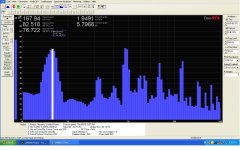
32 Hz., mike 4 feet away.
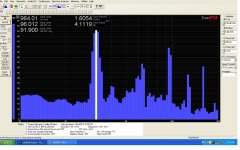
64 Hz., mike 4 feet away.
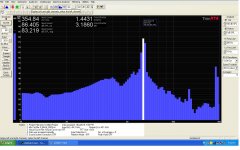
I did use REW to run some sine wave sweeps from 10 Hz. to 96 Hz. I carefully watched the speaker cone for movement. There was very little movement down to 16 Hz. Below that the movement increases. But Xmax on this driver is roughly 22mm. That is just over 3/4 of an inch. I don't think the driver ever reached that point.
Bach On
16 Hz, mike 4 feet away.

32 Hz., mike 4 feet away.

64 Hz., mike 4 feet away.

I did use REW to run some sine wave sweeps from 10 Hz. to 96 Hz. I carefully watched the speaker cone for movement. There was very little movement down to 16 Hz. Below that the movement increases. But Xmax on this driver is roughly 22mm. That is just over 3/4 of an inch. I don't think the driver ever reached that point.
Bach On
Looking at all your measurements leads me to a question.
Is your existing Bourdon rank giving you sufficient power?
Making your comparison measurements are important because you are looking to replace an existing rank of pipes. And then augment them.
Last but not least. At or near a vented box tuning frequency you have the least amount of excursion.
And, you have 22 mm of Xmax, and 44 mm of total available mechanical excursion. The total possible distortion goes up as you leave the Xmax region, but you can use more if you need it.
Is your existing Bourdon rank giving you sufficient power?
Making your comparison measurements are important because you are looking to replace an existing rank of pipes. And then augment them.
Last but not least. At or near a vented box tuning frequency you have the least amount of excursion.
And, you have 22 mm of Xmax, and 44 mm of total available mechanical excursion. The total possible distortion goes up as you leave the Xmax region, but you can use more if you need it.
Looking at all your measurements leads me to a question.
Is your existing Bourdon rank giving you sufficient power?
Making your comparison measurements are important because you are looking to replace an existing rank of pipes. And then augment them.
Last but not least. At or near a vented box tuning frequency you have the least amount of excursion.
And, you have 22 mm of Xmax, and 44 mm of total available mechanical excursion. The total possible distortion goes up as you leave the Xmax region, but you can use more if you need it.
The existing Bourdon is just loud enough for the existing organ. It was placed right in front of the shades to get more of the sound out into the Sanctuary. It is the only 16 foot stop in the pedals.
On the new configuration, we'll replace these pipes with a digital 16 foot version. We're also adding a 16 foot Diapason. The pedal division will also have a tab labeled "Pedal Alterable". My thinking is that this tab will initially be assigned to a 16 foot Fagatto. But it can also be assignaced to other ranks. This is where can assign the 32 foot Diapason when it is needed. We'll also have a 32 foot Contra Violon, a 16 foot Principal and a 16 foot Lieblich Gedeck to choose from.
Early in this thread, many had suggested that getting the sounds from the back of the speaker chamber through the pipe chamber and out the shades would cause a drastic loss in the SPL of the pedal sounds. I understand that this is not uncommon. Many put one or more of their bass speakers in front of the shades in the Sanctuary. I'd rather not do that.
We don't have any extra money to spend right now. But I've discovered that there is a pretty spacious area above the ceiling of the speaker and the pipe chambers. This is space between the ceiling and the roof of the building. We could cut a 2 x 3 foot hole in the ceiling and install a couple of Infinite Baffle drivers there.
Some over at the organ forum are concerned about cone excursion on the bass speakers. They make the case that a large sealed box has a smoother frequency response curve. One has done his own sims on the SI HT18 in this new box. He feels that we'll get excessive movement below 20 Hz. He wanted me to buy that Dayton UM18 driver instead of the HT18 from Stereo Integrity. He feels the Qts of this driver is wrong for the box.
I've long realized that our initial setup won't be close to perfect. Too much of our budget was required for the console and MIDI work. I don't like cutting corners on the speakers. But I'm confident that additional money will gradually replenish our organ fund over time. So we have weeks, months and years ahead where we can make improvements.
Bach On
.
Bach On, you may want to try measuring "near field", with the mic right next to the speaker cone (and also next to the port), maybe 1 cm away. You'll get less room, and more accurate results.
I took these two measurements.
First, mike 6 inches from top of the driver. 16 Hertz.
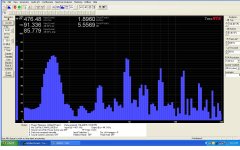
On this one, I placed the mike on the carpeted floor about a half inch from the port. This was a sine wave at 64 Hertz.
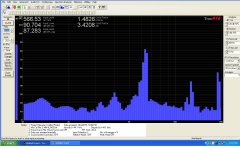
Bach On
OK. Here are some preliminary figures on speaker costs so far.
We bought the 10 Allen HC12s for $200.
The seller threw in two boxes with a total of 8 Allen Presence Presenter Boxes.
We rented an enclosed U-haul trailer for the trip.
It was 1,600 miles round-trip.
The church paid for the trailer - $85.
I paid for the gas, food and lodging. About $250.
The surround kits were about $140 for the HC12s. I did the work myself.
I bought one Allen HR100 off eBay for $240.
The two Dayton ST385-15 inch drivers cost $260
The Stereo Integrity HT18 was $174.
I spent about $150 on the lumber for the two boxes.
I bought some ceiling/wall hanger brackets for the Allen Presence Presenter - $50.
I'm not going to include the amps, wires, patch cords and numerous other incidentals.
So I get a speaker cost of roughly $1,185.
As a bonus, we sold a pair of the HC12s to a nice man for $125.
That brings our speaker costs to roughly $1060.
The cost the church paid for the speakers comes to: $655.
That's for six refurbished Allen HC12s (woofers and mid-range drivers)
A 13 cubic foot bass box with two 15 inch Dayton ST385 drivers
A 10 cubic foot bass box with one SI HT18 driver
Six Allen Presence Presenter speakers in small cabinets.
We still have two spare HC12s with refurbished woofers and mid-range speakers. One has a dimpled dome on the tweeter and there is a cut wire on one of the crossovers. I suspect we'll end up junking these or saving the drivers for replacement use.
Most of the Swell stops of the upper manual will play through two Allen HC12s.
Most of the Great stops of the lower manual will play through different HC12s.
The Celestes, Reeds and Mixtures from both manuals will play through two different HC12s.
Each of these six speakers MAY also be connected to one Allen Presence Presenters hung from the ceiling and spread out within the pipe chamber to give us a bit more separation.
That's it for now.
Bach On
We bought the 10 Allen HC12s for $200.
The seller threw in two boxes with a total of 8 Allen Presence Presenter Boxes.
We rented an enclosed U-haul trailer for the trip.
It was 1,600 miles round-trip.
The church paid for the trailer - $85.
I paid for the gas, food and lodging. About $250.
The surround kits were about $140 for the HC12s. I did the work myself.
I bought one Allen HR100 off eBay for $240.
The two Dayton ST385-15 inch drivers cost $260
The Stereo Integrity HT18 was $174.
I spent about $150 on the lumber for the two boxes.
I bought some ceiling/wall hanger brackets for the Allen Presence Presenter - $50.
I'm not going to include the amps, wires, patch cords and numerous other incidentals.
So I get a speaker cost of roughly $1,185.
As a bonus, we sold a pair of the HC12s to a nice man for $125.
That brings our speaker costs to roughly $1060.
The cost the church paid for the speakers comes to: $655.
That's for six refurbished Allen HC12s (woofers and mid-range drivers)
A 13 cubic foot bass box with two 15 inch Dayton ST385 drivers
A 10 cubic foot bass box with one SI HT18 driver
Six Allen Presence Presenter speakers in small cabinets.
We still have two spare HC12s with refurbished woofers and mid-range speakers. One has a dimpled dome on the tweeter and there is a cut wire on one of the crossovers. I suspect we'll end up junking these or saving the drivers for replacement use.
Most of the Swell stops of the upper manual will play through two Allen HC12s.
Most of the Great stops of the lower manual will play through different HC12s.
The Celestes, Reeds and Mixtures from both manuals will play through two different HC12s.
Each of these six speakers MAY also be connected to one Allen Presence Presenters hung from the ceiling and spread out within the pipe chamber to give us a bit more separation.
That's it for now.
Bach On
I ran some more measurements tonight. I was careful to make sure the mike signal was not too hot. These are TrueRTA, not REW.
16 Hz, mike 4 feet away.
View attachment 493020
There's still a lot of distortion showing up in that response curve. Look at the peak at 48 Hz - it's as high as, if not higher than, the one at 16 Hz.
When you're doing these tests, try switching TrueRTA to Oscilloscope mode, and then adjust the V/div and ms/Div settings until you have at least one full waveform on screen. If the top of the waveform appears to be flattened out, then something along the signal chain is being overloaded.
Do you have any of the other speakers on when you're performing these tests?
For comparison purposes, here's the response of my POC3 to a 40 Hz signal. Notice the significant difference between the fundamental and the overtones @ 80 Hz and 120 Hz? Given the size and Xmax of the HT18 driver, you should be achieving very similar results with your build at 16 Hz.
Attachments
- Status
- This old topic is closed. If you want to reopen this topic, contact a moderator using the "Report Post" button.
- Home
- Loudspeakers
- Subwoofers
- 16Hz for church organ
